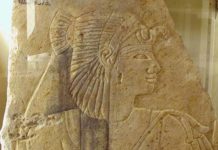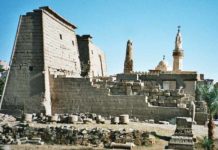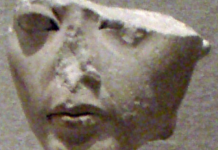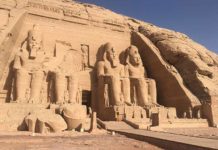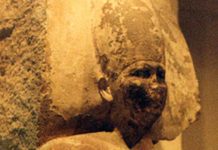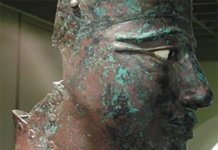It was during the Egyptian Old Kingdom (2613-2181 BC) that the institution of kingship was first consolidated. Out of tribal squabbles in the pre-dynastic era, the pharaoh emerged as commander of a vast state apparatus. Drawing on the divine right of kings, he could conscript labour, seize land and extract taxes at will. However, this seemingly limitless authority was constrained in numerous ways. Chief among these was the necessity of having to rely upon delegates to carry out the day-to-day management of the country. In theory, delegates were supposed to prioritise the interests of the pharaoh. However, these local rulers gradually developed their own power bases independent of the central government.
Whether delegates could be relied upon to carry out orders was dependent upon the prevailing economic conditions. As provincial lords gained increasing wealth at the expense of the central government, they saw themselves on par with the pharaoh, and this is reflected in their decorated monumental tombs that began to appear throughout Egypt. The collapse of the royal court and the onset of the First Intermediate Period was thus a product of increasing fiscal imbalance. Other factors – such as climatic change – no doubt exacerbated an already dire situation, yet they were not on their own sufficient to bring about sudden disorder at the end of the Old Kingdom.
With the exception of the Hyksos period, the roots of historical change in Egypt can be traced to internal sources. Therefore, it is necessary to examine the domestic events preceding the Old Kingdom’s collapse to understand what, if any, factors may have contributed to the weakening of the central government vis-vis the provinces.
One of the most important events was the construction of grandiose monuments such as the Sphinx and the Giza pyramids. These public works projects were for the benefit of the pharaoh and his chosen few, and can be contrasted with the flat-topped mastabas of lesser princes, courtiers and officials. The first king of Dynasty III, Djoser, was responsible for constructing the Step Pyramid at Sakkara overlooking the capital of Memphis. It is a massive structure rising in six unequal stages to a height of 204 feet. As Alan Gardiner observes, ‘Egypt has no more remarkable spectacle to offer’. Other kings of the dynasty also left behind tombs of their own: for instance, the Layer pyramid a few miles south of Giza.
Dynasty IV saw the construction of five great pyramids of outstanding technical merit. The dynasty begins with Snofru, who reigned for 24 years. Snofru built many memorials as well as two stone pyramids – the Northern Stone Pyramid and the Bent Pyramid, both at Dahshur. Both exceed 310 feet in height. Some scholars even attribute a third pyramid at Meidum to Snofru. Then, of course, there is the Great Pyramid at Giza, a feat that ‘surpasses in bulk every building known to have been raised by the enterprise of man’. The three pyramids at Giza were built by Cheops, Chephren and Mycerinus.
The magnificence of the pyramid was a propagandistic tool designed to represent the pharaoh’s link to the gods. In Dynasty V however, some of the ostentatious grandeur of the past two dynasties was lost. Although several pyramids were constructed, they are described by Gardiner as being ‘greatly inferior’ to their Dynasty IV counterparts in size. As a result, there must have been some corresponding loss in the stature of the kingship.
The architecture of the Old Kingdom was not achieved on the back of slave labour. Only a minority of workers were slaves, with the vast majority being provided food and wages. From the point of view of the central government, this was a major shortcoming. While payment for services may have been the most humane course, it also placed a tremendous strain on royal finances, hence weakening the administration.
Another source of fiscal strain was the numerous foreign campaigns conducted by the dynastic kings into Nubia and Punt, among others. And although strictly not a domestic factor, there was also foreign infiltration into Egypt during the 6th dynasty by Asiatics: ‘The archaeological evidence definitely proves that the growing Asiatic menace, which we could trace under the Sixth Dynasty, actually developed into a Syrian influx’. This foreign interference, albeit nowhere on the scale of the Hyksos invaders during the Second Intermediate Period, may have hastened the downfall by destabilising the government at a crucial time.
The growing influence of the priests and nobles further weakened the fiscal position of the king. To keep these two groups onside, kings increasingly gave temples tax-exempt status or transferred land to favoured elites, thereby reducing the assets available for use by the central government. Perhaps due to the sharp rise in influence of the priests, six of the nine kings of Dynasty V are known to have built sun-temples.
From dynasties I to IV, governors loyal to the pharaoh directed the administration of the provinces. But in the fifth dynasty two distinctive trends contributed to a weakening of loyalty towards the centre. First, it became commonplace for administrators to take up permanent residence in the areas they managed, leaving them more susceptible to being influenced by the local population, particularly as the nomes often could withhold wealth from the central authorities. Secondly, succession in these delegated positions became hereditary, thereby limiting the power of pharaohs to appoint loyalists. The strong central state of the Old Kingdom thus came tumbling down, undermined by the very regional governments it had empowered.
Recent research also reveals climatic variation that is likely to have had an adverse impact on the well-being of the State. The rise in drought lowered agricultural yields and placed greater pressure on finances as a consequence of lost tax revenue. As Harvey Weiss writes: “Sometime around 2200 B.C. seasonal rains became scarce, and withering storms replaced them. The winds cut through northern wheat fields and blanketed them in dust. They emptied out towns and villages, sending people stumbling south with pastoral nomads, to seek forage along rivers and streams. For more than a hundred years the desertification continued, disrupting societies from southwestern Europe to central Asia. Egypt’s Old Kingdom, the towns of Palestine and the great cities of the Indus Valley… were among the casualties.”
Although mainstream Egyptologists accept that climate change occurred during the Old Kingdom, the key dispute is over whether climate or economic management is the primary casual factor leading to its collapse. The archaeologist Joseph Tainter has declared it doubtful that ‘any large society has ever succumbed to a single-event catastrophe [such as climate change]’. But others, like Weiss, argue that climatic change was the ‘first domino’ that sent the Old Kingdom toppling.
Certainly, the paternalistic nature of social organisation in Egypt, where the pharaoh was expected to allocate resources according to need, meant that drought leading to famine would have reflected badly upon the ruling class. Furthermore, it is true that the rise and fall of civilisations coincide with climatic variations. For example, there is no pattern of collapse in 2700 BC or in 2500 BC, only in 2200 – the time of reduced rainfall. The rise of Middle Kingdom Egypt also coincides with a decrease in windblown dust.
Nevertheless, any theory of historical change that puts primary emphasis on catastrophic climatic change needs to account for the natural human tendency to adapt. This Weiss has failed to do. A drought invites numerous adaptive measures that could have lessened its effects, such as diversification of crops and herd measures, relying more on imported food, etc. Why did the pharaoh not adopt such alternatives to stave off the undermining of his legitimacy? The answer, as this essay has emphasised, lies in the fiscal situation at the time. Towards the end of the Sixth Dynasty under Pepi I and II, the central administration was reaping the consequences of reckless spending on public works. Had the fiscal situation been stronger, it is likely that adverse climate change would have had much less impact. As Malek points out, ‘the spectre of famine due to Nile failure in individual years must have haunted the Egyptians to greater or lesser degrees throughout all periods of Egyptian history’. Only if we assume that Egyptians failed to learn from past experience with drought – surely an implausible assertion – can one suggest that climate change brought about the collapse of the Old Kingdom.
The Egyptians were not a civilisation incapable of adapting to climate change, however decades of expensive public works projects had led to a dire fiscal position that made adaptation extremely difficult. The public treasury had been drained, leaving few resources to assist during times of drought and famine. It is reasonable to think that this in turn led to an increase in scepticism of the pharaoh. The provincial lords were able to indict the failure of central authorities and generate goodwill by providing relief to the people themselves, which helped propel their rise.
Bibliography:
- David, Rosalie. Handbook to Life in Ancient Egypt (New York: Facts on File Inc., 2003).
- Frankfort, H. “Egypt and Syria in the First Intermediate Period.” Journal of Egyptian Archaeology, 12 (1926): 90-95.
- Gardiner, Alan. Egypt of the Pharaohs: An Introduction (Oxford: Clarendon Press, 1961).
- Malek, Jaromir. “Old Kingdom”, in Oxford History of Ancient Egypt (Oxford: Oxford University Press, 2000), 121-124.
- Tainter, Joseph. The Collapse of Complex Societies (Cambridge: Cambridge University Press, 1988).
- Trigger, B. Ancient Egypt: A Social History (Cambridge: Cambridge University Press, 1983).
- Weiss, Harvey. June 1996. “Desert Storm: Drought, wind and dust, not failing leadership or military conquest, brought destruction to the first of the ancient civilizations”.



